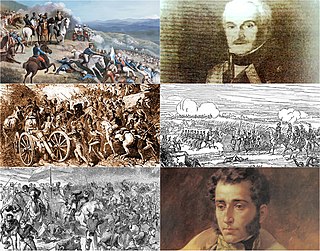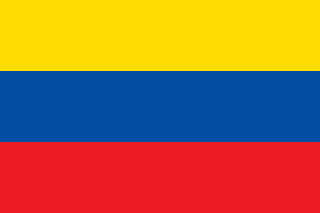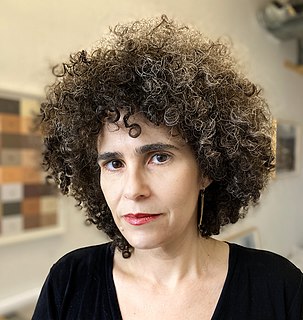
Ecuador, officially the Republic of Ecuador, is a country in northwestern South America, bordered by Colombia on the north, Peru on the east and south, and the Pacific Ocean on the west. Ecuador also includes the Galápagos Islands in the Pacific, about 1,000 kilometers (621 mi) west of the mainland. The country's capital and largest city is Quito.
The History of Ecuador extends over an 8,000-year period. During this time, a variety of cultures and territories influenced what has become the Republic of Ecuador. The history can be divided into six eras: Pre-Columbian, the Conquest, the Colonial Period, the War of Independence, Gran Colombia and Simón Bolívar, and the final separation of his vision into what is known today as the Republic of Ecuador.

Santa Ana de los Cuatro Ríos de Cuenca, commonly referred to as Cuenca is the capital and largest city of the Azuay Province of Ecuador. Cuenca is located in the highlands of Ecuador at about 2,560 metres above sea level, with an urban population of approximately 329,928 and 661,685 inhabitants in the larger metropolitan area.

The 1993 Copa América was the 36th Copa América, CONMEBOL's football tournament for national teams. It was held in Ecuador between 15 June and 4 July. All 10 CONMEBOL members took part, but for the first time two nations from outside CONMEBOL were invited to take part in the tournament, to round out the format. Mexico and the United States, both of CONCACAF, were the invited teams for this tournament. Argentina defeated Mexico in the final 2–1 to win their record 14th continental championship, also their last senior title until 2021.

The Ecuadorian–Peruvian territorial dispute was a territorial dispute between Ecuador and Peru, which, until 1928, also included Colombia. The dispute had its origins on each country's interpretation of what Real Cedulas Spain used to precisely define its colonial territories in the Americas. After independence, all of Spain's colonial territories signed and agreed to proclaim their limits in the basis of the principle of uti possidetis juris, which regarded the Spanish borders of 1810 as the borders of the new republics. However, conflicting claims and disagreements between the newly formed countries eventually escalated to the point of armed conflicts on several occasions.

The Battle of Pichincha took place on 24 May 1822, on the slopes of the Pichincha volcano, 3,500 meters above sea-level, right next to the city of Quito, in modern Ecuador.

The Ecuadorian War of Independence was fought from 1820 to 1822 between several South American armies and Spain over control of the lands of the Royal Audience of Quito, a Spanish colonial administrative jurisdiction from which would eventually emerge the modern Republic of Ecuador. The war ended with the defeat of the Spanish forces at the Battle of Pichincha on May 24, 1822, which brought about the independence of the entire lands of the Real Audiencia of Quito. The Ecuadorian War of Independence is part of the Spanish American wars of independence fought during the first two decades of the 19th century.

The Gran Colombia–Peru War of 1828 and 1829 was the first international conflict fought by the Republic of Peru, which had gained its independence from Spain in 1821, and Gran Colombia, that existed between 1819 and 1830.
Mateo de la Mata Ponce de León was a Spanish colonial official in Peru. He was president of the Audiencia of Quito from 1691 to 1699. From March 2 to August 15, 1716 he served as interim viceroy of Peru.

The Real Audiencia of Quito was an administrative unit in the Spanish Empire which had political, military, and religious jurisdiction over territories that today include Ecuador, parts of northern Peru, parts of southern Colombia and parts of northern Brazil. It was created by Royal Decree on 29 August 1563 by Philip II of Spain in the city of Guadalajara. It ended in 1822 with the incorporation of the area into the Republic of Gran Colombia.

Mariscal Lamar International Airport is a high elevation airport serving Cuenca, the capital of the Azuay Province in Ecuador. It is named after the Peruvian military leader and politician José de la Mar, a native of Cuenca.

The Ecuadorian–Peruvian War took place between 1857 and 1860. The conflict began when Ecuador attempted to sell Amazon basin land claimed by Peru in order to settle a debt with British creditors. When diplomatic relations between the two countries broke down, prior to the fragmentation of the Ecuadorian government into several competing factions, the Peruvian government ordered a blockade of Ecuador's ports in order to force the cancellation of the sale, and the official acknowledgement of Peruvian ownership of the disputed territories. By late 1859, control of Ecuador was consolidated between General Guillermo Franco, in the city of Guayaquil, and a provisional government in Quito headed by Gabriel García Moreno. Peruvian President Ramón Castilla sailed to Guayaquil with several thousand soldiers in October 1859, and negotiated the Treaty of Mapasingue with General Franco in January 1860. The signing of the treaty indicated Ecuadorian compliance with all of Peru's demands, and temporarily marked the end of the territorial dispute between the two countries. However, in September 1860, the forces of the provisional government, commanded by García Moreno and General Juan José Flores defeated Franco's government at the Battle of Guayaquil, ending the civil war in Ecuador. The new government disavowed the Treaty of Mapasingue, followed shortly afterwards by its Peruvian counterpart; this re-opened the territorial dispute.

The history of the Republic of Ecuador from 1830 to 1860 begins with the collapse of the nation of Gran Colombia in 1830, followed by the assassination of Antonio José de Sucre and the death of Simón Bolívar from tuberculosis the same year. Heartbroken at the dissolution of Gran Colombia, Bolívar is quoted to have said shortly before his death, "America is ungovernable. Those who have served the revolution have plowed the sea." These words would seem prophetic during the chaotic first thirty years in the existence of Ecuador.

The Battle of Tarqui, also known as the Battle of Portete de Tarqui, took place on 27 February 1829 at Tarqui, near Cuenca, today part of Ecuador. It was fought between troops from Gran Colombia, commanded by Antonio José de Sucre, and Peruvian troops under José de La Mar. Although the Colombian troops achieved victory over the Peruvian vanguard, destroying it and forcing the rest of their forces to withdraw, they suffered heavy losses in their cavalry with the Peruvian charge, which made it difficult to continue the campaign and caused the stabilization of the front.
Jennifer Stephanie Pazmiño Saldaña is an Ecuadorian-American TV host, radio host, model and beauty pageant titleholder who placed as the second runner-up at Miss Ecuador 2008, representing Guayaquil. As the second runner-up Pazmiño was crowned Miss Ecuador International 2008. She represented Ecuador at Miss International 2008, where she placed Top 12. Two years later Pazmiño was appointed and crowned as Miss Earth Ecuador 2010 by Jose Hidalgo her National Director. Pazmiño represented Ecuador at Miss Earth 2010 she became the first delegate from Ecuador to win the title Miss Earth-Air elemental crown.

Carmen Acevedo Vega was an Ecuadorian poet, writer, and journalist.

Karina Aguilera Skvirsky is a multidisciplinary artist based in New York, New York. Her work is held in the permanent collections of the Brooklyn Museum, the New York Public Library, the Art Institute of Chicago, and the Whitney Museum, among others. Working across video, performance, and photography, Aguilera Skvirsky addresses themes of migration, colonization, Latin American identity, and family history. Aguilera Skvirsky is best known for her performance video The Perilous Journey of María Rosa Palacios (2019).

The Free Province of Guayaquil was a South American state that emerged between 1820 and 1822 with the independence of the province of Guayaquil from the Spanish monarchy. The free province had a provisional government and constitution until its annexation to Gran Colombia in 1822. Its successor was the Department of Guayaquil forming part of Gran Colombia. The Spanish province of Guayaquil was separated from the Viceroyalty of Peru and in those days it only depended legally on the court of the Real Audiencia de Quito. About a decade later the Departments of Guayaquil, Azuay and Ecuador separate from Gran Colombia forming the current Ecuador.

The 1827 Guayaquil uprising, also known as the Guayaquil Department rebellion, was a set of actions carried out by the Guayaquil authorities —during its period as a department of Gran Colombia— in rejection of the centralist policies of the Republic of Colombia and others that harmed the interests of various municipalities. This is one of the first rebellions with a separatist tint that took place in the country of Gran Colombia prior to the start of its dissolution process in 1829.

The Revolution of October 9, 1820, in Guayaquil, was an event whose purpose was the independence of Guayaquil and breaking the colonial ties that existed between the Province of Guayaquil and the Spanish Empire, and that gave way to the emergence of the Free Province of Guayaquil as an independent state. The independence of Guayaquil revived the war of independence of the Real Audiencia de Quito as part of the emancipatory wars of Spanish America. Among the main factors that concur in this event are the uprising of the Spanish garrison of the city of Guayaquil, formed essentially by the Cuzco Reserve Grenadier regiment, and the control of the Pacific by the Liberating Expedition of Peru, under the command of José of San Martín, with whom Olmedo contacts immediately through the schooner Alcance.


















